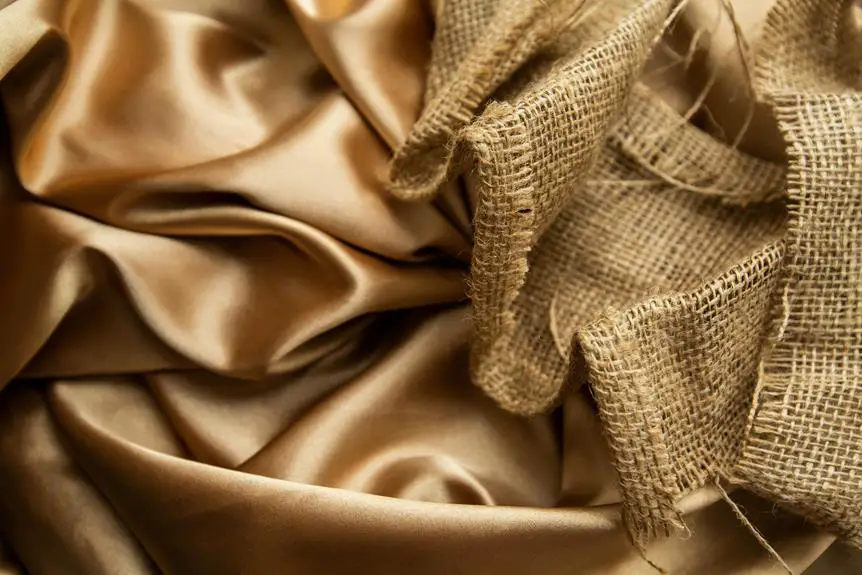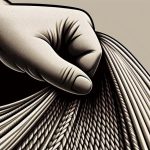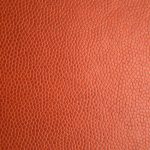When you're choosing between canvas and duck cloth, it's crucial to understand their distinct characteristics. Canvas, with its tighter weave, offers breathability and a smoother texture, making it great for lightweight applications. On the other hand, duck cloth's looser weave and thicker feel provide enhanced durability for heavy-duty use. Knowing these differences can guide your fabric selection for various projects, but the implications of your choice go beyond just durability. What other factors should you consider to ensure you're making the best decision?
Table of Contents
Key Takeaways
- Canvas features a tighter plain weave, offering a smoother texture, while duck cloth has a looser, more complex weave with a coarser feel.
- Duck cloth is generally heavier and more durable than canvas, making it ideal for heavy-duty applications like outdoor gear and workwear.
- Canvas is more breathable, making it suitable for items needing ventilation, while duck cloth excels in water and UV resistance.
- Both fabrics are versatile for upholstery projects, but canvas is often preferred for lighter applications, while duck cloth is better for high-traffic areas.
Definition of Canvas
Canvas is a heavy-duty fabric made from cotton, linen, or synthetic fibers, designed for durability and versatility in various applications. You'll find it commonly used in items like tents, awnings, backpacks, and even shoes. Its tight weave gives it strength, making it resistant to wear and tear.
When you choose canvas, you're opting for a material that can withstand the elements, whether it's rain or sun. The fabric can be treated with coatings or finishes to enhance its water resistance and UV protection. This adaptability makes canvas a favorite for both outdoor and indoor uses.
Canvas comes in various weights and finishes, so you can select the right type for your specific needs. A heavier weight canvas offers more durability, while lighter options are easier to handle and manipulate.
You'll also appreciate that canvas can be easily printed on or dyed, allowing for creative expression in design. Whether you're an artist looking to create a masterpiece or someone who needs reliable material for a project, canvas is a dependable choice that delivers quality and functionality.
Definition of Duck Cloth
Duck cloth is a durable, heavy fabric that has its roots in the 19th century, originally made for sailmaking.
You'll find it composed of cotton or a cotton blend, giving it strength and versatility.
This fabric is commonly used in applications like tents, bags, and workwear, making it a favorite for both outdoor and industrial uses.
Origin and History
Originating from the Dutch word 'doek,' which means cloth, duck cloth has a rich history rooted in practicality and durability. You might be surprised to learn that this fabric dates back to the 17th century, initially crafted in Europe for various utilitarian purposes. Sailors often relied on it for sails, tents, and other heavy-duty applications due to its robust nature.
As you explore its evolution, you'll notice that duck cloth became increasingly popular in the United States during the 19th century. It was commonly used for work garments and outdoor gear, appealing to those who needed reliable and tough materials. The fabric's ability to withstand harsh conditions made it a staple in industries like agriculture and construction.
As you delve deeper into its significance, you can see how duck cloth's attributes have allowed it to adapt over time. Today, you'll find it not just in workwear but also in fashion and home décor. Its journey from a practical necessity to a versatile fabric showcases its enduring appeal.
Understanding this history can help you appreciate the unique qualities duck cloth brings to the table compared to canvas.
Fabric Composition
When it comes to fabric composition, duck cloth typically consists of cotton or a cotton blend, making it sturdy yet breathable for various applications. This fabric is known for its tight weave, which gives it a high level of durability. You'll often find that it's heavier than standard cotton, usually weighing between 8 to 12 ounces per square yard. This weight contributes to its strength, making it resistant to wear and tear.
Duck cloth can also be made with synthetic fibers mixed in, enhancing its water resistance and overall performance. When you're considering duck cloth for your projects, pay attention to the fiber content. A higher percentage of cotton will provide that classic feel and breathability, while blends can offer additional benefits, like reduced wrinkling and increased durability.
This fabric is typically finished with a treatment that enhances its ability to repel moisture and stains, making it suitable for outdoor use. Overall, duck cloth's composition is tailored for those seeking a robust material that can withstand demanding environments while still maintaining comfort and usability.
Common Uses
Commonly used in various applications, duck cloth is perfect for items like bags, tents, and outdoor gear due to its durability and water-resistant properties. You'll find it's a favored choice among outdoor enthusiasts and craftsmen alike. Its tough nature makes it ideal for heavy-duty items that need to withstand the elements.
Here's a quick look at some common uses of duck cloth:
| Use Case | Description |
|---|---|
| Bags | Great for backpacks, tote bags, and duffels. |
| Tents | Excellent for camping and outdoor events, providing shelter and protection. |
| Outdoor Gear | Perfect for making tarps, awnings, and protective covers. |
These examples illustrate how versatile duck cloth can be in your projects. Whether you're crafting something for a weekend adventure or a sturdy bag for daily use, duck cloth offers the reliability you need. Its strength and water resistance ensure your gear stands the test of time and weather, making it a go-to fabric for various applications. So, if you're considering a project, duck cloth is definitely worth your attention!
Key Differences
Canvas and duck cloth differ primarily in their weave, thickness, and intended uses, making each fabric suitable for specific projects.
Canvas typically features a tighter weave, which gives it a smoother finish and makes it more versatile for various applications. Duck cloth, on the other hand, has a looser weave and is generally thicker, making it more durable and robust.
Here are some key differences to consider:
- Weave Type: Canvas has a plain weave, while duck cloth often uses a more complex weave that enhances its strength.
- Thickness: Duck cloth is usually thicker than canvas, providing extra durability for heavy-duty tasks.
- Texture: Canvas tends to be smoother to the touch, while duck cloth has a coarser feel due to its heavier fibers.
Understanding these key differences helps you choose the right fabric for your specific needs, ensuring your projects turn out just the way you envisioned.
Common Uses of Canvas
You'll find canvas is often used for a variety of applications, including bags, upholstery, and outdoor gear. Its durability and versatility make it a go-to material for many projects.
When you need a sturdy bag, whether it's for groceries, travel, or school, canvas is your best friend. It holds up well against wear and tear, so you can trust it to carry your essentials without falling apart.
If you're into DIY projects, canvas is fantastic for upholstery. It's easy to clean and resistant to fading, making it perfect for furniture that sees a lot of use. You can breathe new life into old chairs or sofas with a fresh canvas cover.
For outdoor gear, canvas shines as well. You'll often find it in tents, backpacks, and tarps, thanks to its weather-resistant properties. If you're planning a camping trip, you'll appreciate how canvas keeps you protected from the elements.
Additionally, artists love canvas for painting. Its texture offers a great surface for various mediums, from oil to acrylic.
Common Uses of Duck Cloth
Duck cloth is often chosen for applications like heavy-duty bags, workwear, and outdoor equipment due to its exceptional strength and durability. This fabric's unique weave provides a robust texture that can withstand wear and tear, making it ideal for various practical uses. You'll find duck cloth in items that need to endure tough conditions while maintaining functionality.
Here are some common uses of duck cloth that you might encounter:
- Work Aprons: Perfect for professionals in kitchens and workshops, offering protection and durability.
- Tote Bags: Often used for reusable shopping bags, thanks to its sturdy construction.
- Outdoor Gear: Ideal for tents and tarps, as it can resist water and UV damage.
With its versatility, duck cloth stands out as a reliable choice for anyone needing dependable fabric for everyday items. Whether you're crafting or purchasing, you can trust duck cloth to deliver quality and endurance in your projects.
Choosing the Right Fabric
When selecting fabric for your project, considering the specific qualities and applications of materials like duck cloth and canvas can help you make an informed choice.
Duck cloth is heavier and more durable, making it ideal for applications that require strength, like outdoor gear or heavy-duty bags. If you need something that can withstand wear and tear, duck cloth might be your best bet.
On the other hand, canvas is lighter and often more versatile. It works well for items like tents, awnings, and art canvases. If your project involves painting or requires a softer finish, canvas can be the better option.
Think about the environment where your fabric will be used. If you're working on something that'll face the elements, duck cloth's water-resistant properties can offer added protection. However, if breathability is a concern, canvas may be more suitable.
Lastly, consider your project's aesthetic. Duck cloth has a more rugged look, while canvas can be found in various colors and finishes. By weighing these factors, you'll be able to choose the fabric that best fits your needs.
Frequently Asked Questions
Can Canvas and Duck Cloth Be Dyed Easily?
You can dye both canvas and duck cloth, but the results may vary. While canvas absorbs dye well, duck cloth often requires more effort due to its tighter weave. Experimenting with different dyes will yield the best results.
Which Fabric Is More Water-Resistant?
When it comes to water resistance, duck cloth usually outperforms canvas due to its tighter weave and denser fibers. If you need a more water-resistant option, duck cloth might be your best choice.
Are There Eco-Friendly Options for Canvas and Duck Cloth?
Yes, you can find eco-friendly options for both canvas and duck cloth. Look for organic cotton or recycled materials that reduce environmental impact while providing durability and functionality for your projects. It's a sustainable choice!
How Do I Clean and Maintain These Fabrics?
To clean and maintain these fabrics, you should spot clean with mild soap and water, avoid harsh chemicals, and air dry. Regularly brushing off dirt helps keep them looking fresh and prolongs their lifespan.
What Is the Weight Difference Between Canvas and Duck Cloth?
When you compare canvas and duck cloth, you'll notice duck cloth is typically lighter, often ranging from 7 to 12 ounces per square yard, while canvas can weigh upwards of 12 ounces to 24 ounces.
- Tetron Fabric for Marine Applications: Durability and Use Cases - June 18, 2025
- Tetron Fabric for Outdoor Furniture: Weather Resistance and Care - June 18, 2025
- Tetron Fabric for Wall Coverings: Style and Application Tips - June 18, 2025







